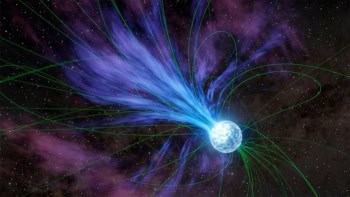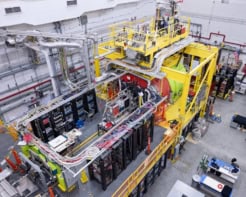A breakthrough in the struggle to understand the synthesis and shape of superheavy elements was made recently at the Argonne National Laboratory near Chicago in the US. An international team of nuclear physicists from the US, France, Finland, Norway and the UK has reported that one very heavy nucleus, nobelium-254, can be remarkably stable, even when it is created in a "high-spin" state (P Reiter et al. 1999 Phys. Rev. Lett. 82 509). The publication comes amid reports of the discovery of an element with 114 protons at the JINR laboratory in Dubna, Russia. If confirmed, this will be the heaviest element yet created.
The existence of superheavy elements was predicted about 30 years ago on the basis of the nuclear shell model, which was originally developed in 1949. The model explains why nuclei with certain “magic” numbers of neutrons or protons are especially stable: these nuclei have closed shells of either protons or neutrons. Magic nuclei are spherical in shape and are characterized by exceptionally high nuclear binding energies. The most stable nuclei observed are “doubly magic”, having closed shells of both protons and neutrons. The heaviest known doubly magic nucleus is 208Pb, an isotope of lead consisting of Z = 82 protons and N = 126 neutrons. The shell model predicts that the next doubly magic nucleus in the sequence will contain 114 protons and 184 neutrons. Other theoretical studies predict a whole superheavy “island of stability” around Z = 114 and N = 184, making the reported discovery of the new element with Z = 114 and N = 175 all the more significant. For a long time it was believed that the island was surrounded by a “sea of instability” consisting of nuclei that have a high probability of fragmenting spontaneously into lighter nuclei. However, the discovery of elements containing between 107 and 112 protons at the Institute for Heavy Ion Research (GSI) in Darmstadt, Germany, showed that this assumption was incorrect. Subsequent theoretical work has explained the observed stability of elements containing up to 112 protons. The stability of these non-magic nuclei is predicted to come from the ability of the nucleus to deform from a spherical shape. Confidence in these theoretical predictions has come from their agreement with experimental measurements of a-decay energies, a-decay lifetimes and long fission lifetimes. Now Peter Reiter, Teng Lek Khoo and co-workers at the ATLAS superconducting linear accelerator in Argonne have directly demonstrated that the nobelium-254 (254No) nucleus, which has 102 protons, is deformed. They have quantified this in terms of a “deformation parameter” and have also discovered that the 254No nucleus is remarkably stable even when it is in a high-spin state, a result that was not obvious for such heavy elements. The experiment combined some of the most highly developed instruments and separation techniques in modern nuclear spectroscopy. In the experiment an intense beam of calcium ions was directed at a lead target. Within a timescale of 10-19 s, a rotating, heavy 256No nucleus was formed, which then cooled by emitting two neutrons to leave a rotating 254No nucleus. As it rotates, this nucleus emits gamma rays that remove the angular momentum and leave the 254No nucleus in its ground state after about 10-9 s. The gamma rays were detected using Gammasphere, an array of 101 germanium detectors. To distinguish the gamma rays emitted by the 254No from the intense background of gamma rays released in other fission reactions, it was essential to correlate their arrival times at the detector with the detection of the 254No nuclei. Heavy nuclei were separated in-flight from lighter nuclear particles using a fragment mass analyser and their positions were accurately measured with a silicon detector. The production of 254No was signalled unambiguously by its characteristic a decay, which occurred at the same position in the silicon detector as the nucleus and had a half-life of 55 s. By “tagging” the gamma spectrum this way, the team found that the energy difference between the various transitions was characteristic of those from a rotating, deformed nucleus. The researchers also used the data to work out the spin of the emitting states. A total of four gamma-ray transitions were identified and assigned to a decay cascade that started from a spin level with 12 units of angular momentum and positive parity (12+). (Parity is a quantum number that can take the value of +1 or -1.) Of the six possible transitions, the two lowest were not observed because the nucleus prefers to transfer its energy to the atomic electrons rather than emit gamma rays at low transition energies. The team deduced the deformation parameter from the difference in energy of the gamma rays coming from the different rotational states and found that it was in excellent agreement with the value predicted by theories. The researchers found that the 254No nucleus is a prolate spheroid (or rugby-ball shape) with an axis ratio of 4:3, as shown in the figure. Shortly afterwards, Matti Leino, Rauno Julin and co-workers repeated the experiment at the University of Jyväskylä in Finland (M Leino et al. 1999 Acta Phys. Pol. B at press). In this experiment, the researchers confirmed a transition from a spin-parity state of 14+ to 12+ that had only been assigned tentatively by the Argonne team. They also discovered a new transition, probably from a spin-parity state of 16+ to 14+. Normally, the centrifugal forces acting on a rotating, heavy nucleus cause it to break up more easily. However, the observation of states that have up to 16 units of spin implies that a fraction of the 254No nuclei remain intact even when they have a high angular momentum. Both groups are planning further investigations into the stability of 254No and its dependence on the angular momentum of the nucleus. The results should provide greater experimental and theoretical insight into the production mechanism of superheavy elements.



